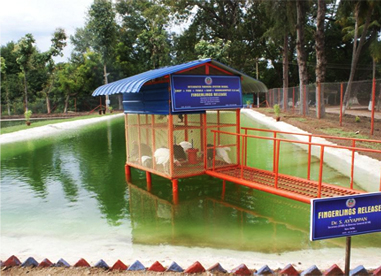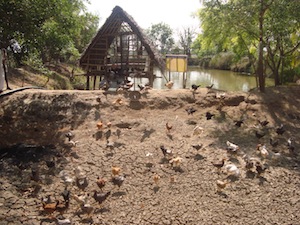Fish-cum-Poultry
- Much attention is being given for the development of poultry farming in India and with improved scientific management practices; poultry has now become a popular rural enterprise in different states of the country.
- Apart from eggs and chicken, poultry also yields manure, which has high fertilizer value.
- The production of poultry dropping in India is estimated to be about 1,300 thousand tons, which is about 390 metric tones of protein.
- Utilization of this huge resource as manure in aquaculture will definitely afford better conversion than agriculture.
Stocking Density of Fish
- The application of poultry manuring in the pond provides a nutrient base for dense bloom of phytoplankton, particularly nano plankton which helps in intense zooplankton development.
- The zooplankton has an additional food source in the form of bacteria which thrive on the organic fraction of the added poultry dung. Thus, indicates the need for stocking phytoplanktophagous and zoo planktophagous fishes in the pond.
- In addition to phytoplankton and zooplankton, there is a high production of detritus at the pond bottom, which provides the substrate for colonization of micro-organisms and other benthic fauna especially the chironomid larvae.
- Another addition will be macro-vegetation feeder grass carp, which, in the absence of macrophytes, can be fed on green cattle fodder grown on the pond embankments.
- The semi digested excreta of this fish forms the food of bottom feeders.
- For exploitation of the above food resources, polyculture of three Indian major carps and three exotic carps is taken up in fish cum poultry ponds.
- The pond is stocked after the pond water gets properly detoxified.
- The stocking rates vary from 8000 - 8500 fingerlings/ha and a species ratio of 40 % surface feeders, 20 % of column feeders, 30 % bottom feeders and 10-20 % weedy feeders are preferred for high fish yields.
- Mixed culture of only Indian major carps can be taken up with a species ratio of 40 % surface, 30 % column and 30 % bottom feeders.
- In the northern and north - western states of India, the ponds should be stocked in the month of March and harvested in the month of October - November, due to severe winter, which affect the growth of fishes.
- In the south, coastal and north - eastern states of India, where the winter season is mild, the ponds should be stocked in June - September months and harvested after rearing the fish for 12 months.
|

TNAU - Poultry-Fish Culture model |

Deveivamani, Farmer, Tiruvarur District
Poultry-Fish Culture model |
Use of poultry litter as manure : The fully built up deep litter removed from the poultry farm is added to fish pond as manure.
Two methods are adopted in recycling the poultry manure for fish farming
The poultry droppings from the poultry farms is collected, stored it in suitable places and is applied in the ponds at regular instalments
- Applied to the pond at the rate of 50 Kg/ha/ day every morning after sunrise.
- The application of litter is differed on the days when algal bloom appears in the pond. This method of manurial application is controlled.
Constructing the poultry housing structure partially covering the fish tank and directly recycling the dropping for fish culture
- Direct recycling and excess manure however, cause decomposition and depletion of oxygen leading to fish mortality. It has been estimated that one ton of deep litter fertilizer is produced by 30-40 birds in a year.
- As such 500 birds with 450 kg as total live weight may produce wet manure of about 25 Kg/day, which is adequate for a hectare of water area under polyculture.
- The fully built up deep litter contain 3% nitrogen, 2% phosphate and 2% potash. The built up deep litter is also available in large poultry farms.
- The farmers who do not have the facilities for keeping poultry birds can purchase poultry litter and apply it in their farms.
- Aquatic weeds are provided for the grass carp.
- Periodical netting is done to check the growth of fish. If the algal blooms are found, those should be controlled in the ponds.
- Fish health should be checked and treat the diseased fishes.
Poultry husbandry practices
The egg and chicken production in poultry rising depends upon multifarious factors such as breed, variety and strain of birds, good housing arrangement, blanched feeding, proper health care
Housing of birds
- In integrated fish-cum-poultry farming the birds are kept under intensive system. The birds are confined to the house entirely.
- The intensive system is further of two types - cage and deep litter system.
- The deep litter system is preferred over the cage system due to higher manurial values of the built up deep litter.
- In deep litter system 250 birds are kept and the floor is covered with litter. Dry organic material like chopped straw, dry leaves, hay, groundnut shells, broken maize stalk, saw dust, etc. is used to cover the floor up to a depth of about 6 inches.
- The birds are then kept over this litter and a space of about 0.3 - 0.4 square meters per bird is provided.
- The litter is regularly stirred for aeration and lime used to keep it dry and hygienic.
- In about 2 month’s time it becomes deep litter, and in about 10 months time it becomes fully built up litter. This can be used as fertilizer in the fish pond.
- The fowls which are proven for their ability to produce more and large eggs as in the case of layers, or rapid body weight gains is in the case of broilers are selected along with fish.
- The poultry birds under deep litter system should be fed regularly with balanced feed according to their age.
- Grower mash is provided to the birds during the age of 9-20 weeks at a rate of 50-70 gm/bird/day, whereas layer mash is provided to the birds above 20 weeks at a rate of 80-120 gm/bird/day.
- The feed is provided to the birds in feed hoppers to avoid wastage and keeping the house in proper hygienic conditions.
Egg laying
- Each pen of laying birds is provided with nest boxes for laying eggs.
- Empty kerosene tins make excellent nest boxes.
- One nest should be provided for 5-6 birds.
- Egg production commences at the age of weeks and then gradually decline.
- The birds are usually kept as layers up to the age of 18 months. Each bird lays about 200 eggs/yr.
Harvesting
- Some fish attain marketable size within a few months.
- Keeping in view the size of the fish, prevailing rate and demand of the fish in the local markets, partial harvesting of table size fish is done.
- After harvesting partially, the pond should be restocked with the same species and the same number of fingerlings depending upon the availability of the fish seed.
- Final harvesting is done after 12 months of rearing. Fish yield ranging from 3500-4000 Kg/ha/yr and 2000-2600 Kg/ha/yr are generally obtained with 6 species and 3 species stocking respectively.
- Eggs are collected daily in the morning and evening. Every bird lays about 200 eggs/year.
- The birds are sold after 18 months of rearing as the egg laying capacity of these birds decreases after that period.
- Pigs can be used along with fish and poultry in integrated culture in a two-tier system. Chick droppings form direct food source for the pigs, which finally fertilise the fish pond.
- Depending on the size of the fish ponds and their manure requirements, such a system can either be built on the bund dividing two fish ponds or on the dry-side of the bund.
- The upper panel is occupied by chicks and the lower by pigs.
Economics of Fish-cum-Poultry
| a) |
Expenditure |
Rs. |
| 1 |
Construction of Pond,Water Supply Channel, Installation of Tube well/Renovation/Lease Amount |
25000 |
| 2 |
Electricity & Water charges |
60000 |
| 3 |
Construction of Poultry Shed ( Rs.150000/- for 10 years) |
15000 |
| 4 |
550 Chicks |
8250 |
| 5 |
22500Kg Poultry Feed |
230000 |
| 6 |
Medicines for Fish & Poultry |
50000 |
| 7 |
Fishing, Sale of Poultry Birds & Labour |
40000 |
| TOTAL EXPENDITURE |
428250 |
| |
|
|
| b) |
Income |
|
| |
Sale of 6000 KG Fish |
300000 |
| |
Sale of 118750 Eggs |
415625 |
| |
Sale of 500 KG Poultry Birds |
50000 |
| |
Total Income |
765625 |
| |
|
|
| c) |
Net Income(B-A) |
337375 |
Note : The income may vary on the productivity and market price of a pond and poultry inputs/ by products
Source: http://agropedia.iitk.ac.in/content/integrated-fish-cum-poultry-farming
Updated on : March 2015 |

